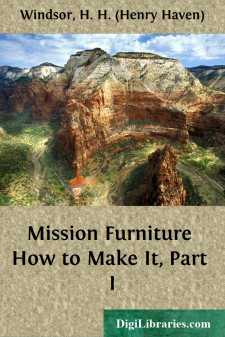Categories
- Antiques & Collectibles 13
- Architecture 36
- Art 48
- Bibles 22
- Biography & Autobiography 813
- Body, Mind & Spirit 142
- Business & Economics 28
- Children's Books 15
- Children's Fiction 12
- Computers 4
- Cooking 94
- Crafts & Hobbies 4
- Drama 346
- Education 46
- Family & Relationships 57
- Fiction 11829
- Games 19
- Gardening 17
- Health & Fitness 34
- History 1377
- House & Home 1
- Humor 147
- Juvenile Fiction 1873
- Juvenile Nonfiction 202
- Language Arts & Disciplines 88
- Law 16
- Literary Collections 686
- Literary Criticism 179
- Mathematics 13
- Medical 41
- Music 40
- Nature 179
- Non-Classifiable 1768
- Performing Arts 7
- Periodicals 1453
- Philosophy 64
- Photography 2
- Poetry 896
- Political Science 203
- Psychology 42
- Reference 154
- Religion 513
- Science 126
- Self-Help 84
- Social Science 81
- Sports & Recreation 34
- Study Aids 3
- Technology & Engineering 59
- Transportation 23
- Travel 463
- True Crime 29
Mission Furniture How to Make It, Part 3
Categories:
Description:
Excerpt
The piano bench shown in the accompanying picture was made of black walnut and was finished natural. The finish was applied in the following manner: First, all the parts were well scraped and sandpapered, then the surface was covered with a coating of boiled linseed oil. After this had stood several hours, or until it had had time to penetrate the wood, the surplus liquid was wiped off with a flannel cloth. After the oil had stood for 48 hours, a thin coat of shellac was applied and allowed to harden overnight. The next morning this shellac was sandpapered lightly with No. 00 paper and a coat of floor wax was applied according to the directions which are found upon every can. Two more coats of wax were applied after intervals of half an hour and the finish was completed. The effect is very pleasing. The oil brings out the rich color of the wood and the shellac and wax serve to preserve the color. The following stock is needed:
- 1 top, 1 by 16-1/2 by 40-1/2 in., S-2-S.
- 4 posts, 1-1/2 by 1-1/2 by 20 in., S-4-S.
- 2 rails, 7/8 by 4-1/4 by 36 in., S-2-S.
- 2 rails, 7/8 by 4-1/4 by 13 in., S-2-S.
- 2 lower rails, 7/8 by 2-1/2 by 13 in., S-2-S.
- 1 stretcher, 7/8 by 3-3/4 by 36 in., S-2-S.
- 6 slats, 3/8 by 1-1/4 by 11 in., S-2-S.
With the exception of the legs all the stock is specified mill-planed to thickness upon two surfaces. The legs are specified planed on four sides. Square the legs to length and the rails, stretcher, slats, etc., to width and length.
Detail of the Piano BenchLay out and work the tenons of the rails and stretcher. The slats are best made without tenons, the whole end of each slat being "housed" into the rails. The reason for this is obvious—it is a difficult matter to fit two or more pieces between fixed parts when their ends are tenoned. When the ends are housed any slight variation in the lengths adjusts itself. It is necessary, however, to chisel the sides of the mortises carefully, but this is a simple matter compared with getting the shoulders of the tenons, etc., all just alike.
Assemble the parts, using good hot glue. Put the ends of the bench together first. When the glue has hardened on these, place the stretcher and side rails. Fasten the top to the frame from the under side, either by glued blocks and screws or by angle irons.
A LIBRARY TABLE
A library table of neat appearance and correct proportions is shown in the accompanying sketch and detail drawing. This table looks best when finished in quarter-sawed oak, although any of the other furniture woods can be used if desired. If the material is ordered from the mill cut to length, squared and sanded, much of the hard labor can be avoided. Order the following pieces:
- 4 legs, 2 by 2 by 30-1/4 in., S-4-S.
- 1 top, 1-1/8 by 30 by 42 in., S-4-S.
- 2 end pieces, 3/4 by 17-1/8 by 29 in., S-2-S.
- 2 top rails, 7/8 by 2 by 37 in., S-4-S.
- 2 top rails, 7/8 by 2 by 25-1/2 in., S-4-S.
- 1 lower brace, 3/4 by 2 by 32 in., S-4-S.
- 4 shelves, 3/4 by 7 by 29 in., S-4-S.
- 8 slats, 1/4 by 1-1/8 by 17-1/8 in., S-4-S.
- 2 drawer fronts, 3/4 by 5-3/4 by 25 in., S-4-S.
- 4 drawer sides, 3/8 by 3-3/4 by 14 in., soft wood.
- 2 drawer ends, 3/8 by 3-3/8 by 24-1/4 in., soft wood.
- 2 drawer bottoms, 3/8 by 13-1/4 by 24-1/4 in., soft wood.
- 2 drawer supports, 3/4 by 2 by 23-1/2 in., soft wood.
- 2 drawer supports, 3/4 by 2 by 25 in., soft wood.
Start work on the legs by beveling the tops and squaring them up and laying out the mortises for the shelves as shown in section BB. Care should be taken to get the legs mortised in pairs and all cut the same height. This is best done by placing the four legs side by side with the ends square, and then laying out the mortises across all four at once with a try-square.
The Finished Library TableThe table top is made of several boards which are doweled and glued together. Be careful to get the best side of each board up and have the joints a tight fit....




